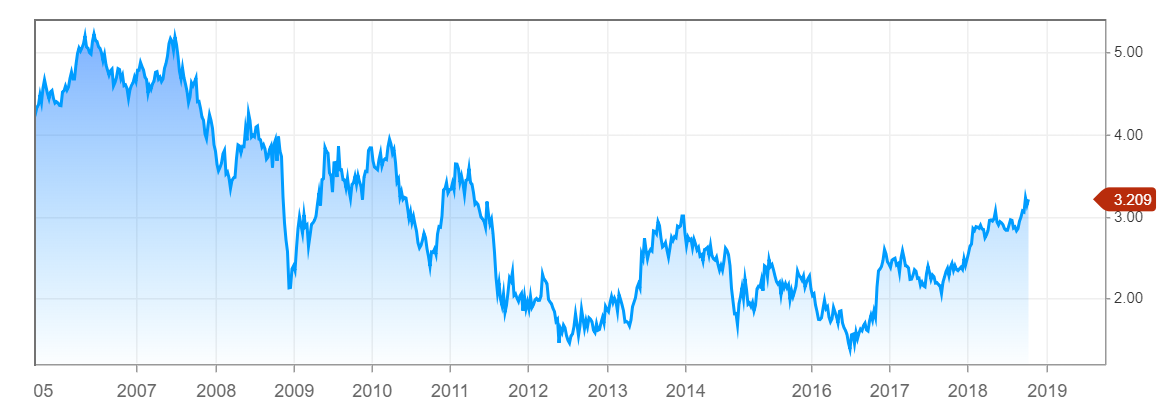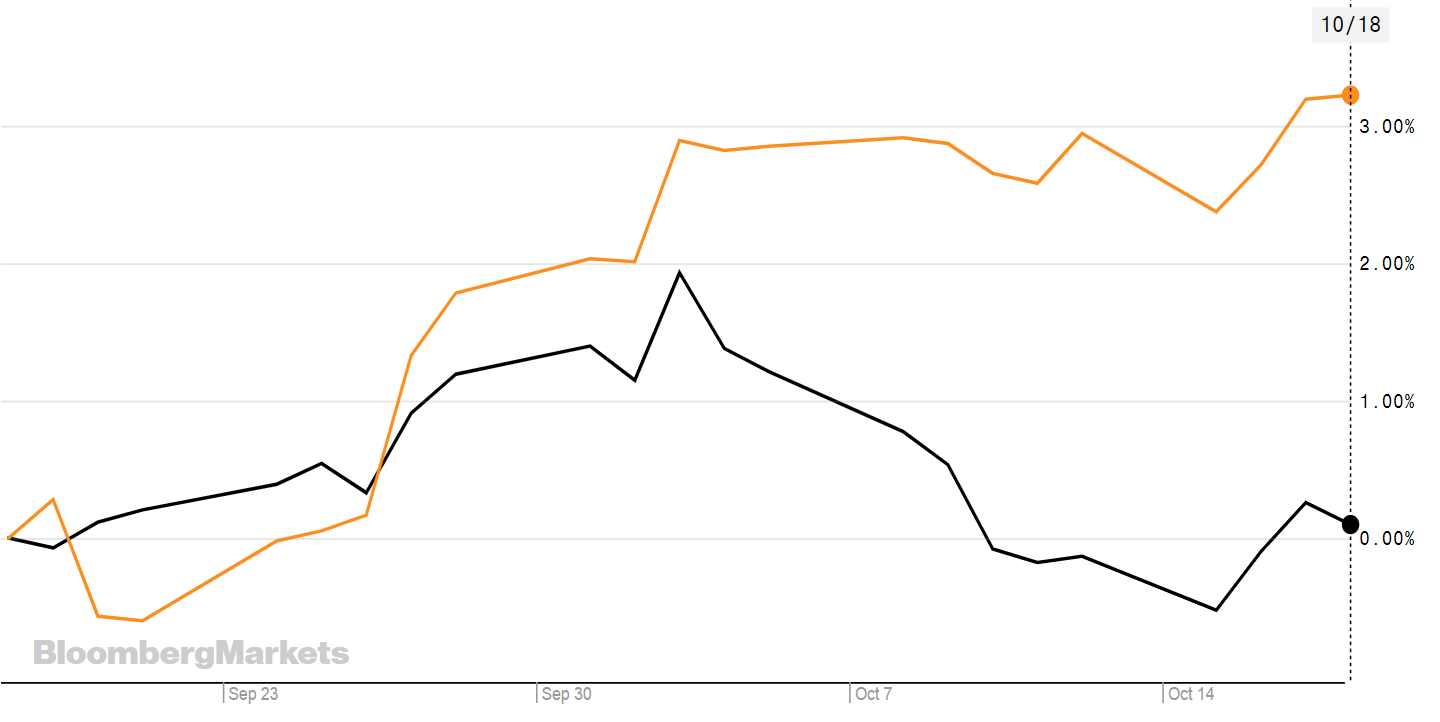Global markets have suffered from a sell off in recent weeks and it could get worse, according to market watchers. So where should investors be positioned and are there any truly safe havens for your capital?
Sam Stovall, chief investment officer at CFRA, said to CNBC he would not be surprised to see a test of last week's lows, and he is not alone. Nuveen Asset Management chief U.S. equities strategist Bob Doll said the market could test its lows before heading to new highs later in the year.
Markets were selling off sharply in early October, with US stocks suffering their worst fall since February. The S&P 500 fell 3.5% in one day on 10th October.
At the same time, the US 10-year treasury yield moved above 3%; an important threshold because it signifies a drop in investor confidence and points to higher interest rates. Rising bond yields are at least part of the reason why share prices have fallen. (As bond prices fall, shares become relatively more expensive unless their prices fall too.)
The chart below shows the U.S. 10-Year yield over the past twelve years.

Source: CNBC
Bond are traditionally seen as low-risk safe havens but they're still at trading at high levels historically, and rates will almost certainly rise from here. So not as safe as all that.
Other traditional safe havens include gold, the US dollar, the Swiss Franc, Japanese Yen, defensive stocks such as utilities and pharmaceuticals, and cash.
The US Dollar has traditionally been the safe haven of choice when it comes to forex markets due to its strong fundamentals and strong growth story. However, in recent weeks the dollar has looked vulnerable.
According to Pound Sterling Live, this is because its fundamentals do not look as attractive to investors as they did only a few months ago. Jane Foley, head of FX strategy with Rabobank, says the U.S.' "twin-deficits" make the Dollar an unsuitable safe-haven but that it was supported as such by a "strong U.S. growth story" until quite recently.
"If you look at the really big picture I would always argue whether the Dollar is a proper safe-haven, after all, it has got a chronic current account deficit, and there is a budget deficit as well," says Foley. "I think the question now is whether that strong US growth story has ended or whether or not what we have just seen is just a little correction in a bull market."
In the context of the forex market, the Swiss Franc is also considered a safe haven currency due to the stability of the Swiss government and its financial system. It is also independent from the European Union, making it fairly immune from negative political and economic events, such as Brexit.
The Japanese Yen is also emerging as a safe haven currency. During times of economic stress investors tend to gravitate to the Yen pushing its value up. This strengthening of the currency during periods of risk-off sentiment has given it safe haven status. The country also has a strong trade surplus.
The chart below shows USDJPY in black and USDCHF in orange.

Source: Bloomberg
Defensive Stocks
Another safe haven is defensive stocks, which include utilities, consumer goods companies and pharmaceuticals. This is on the basis that people will always need these, regardless which way the market is moving. It means that these companies typically keep a lot of their value in times of economic uncertainty.
Cash
Cash is of course a safe haven, but its value can be quickly eroded if inflation picks up.
Gold
Finally, one of the most popular safe havens of all is gold.
Gold's price spiked last week when markets tumbled. The chart below shows the gold price in dollars over the last three months.

Source: www.gold.org
ETF Daily News reported that "Thursday [11th] was a momentous day for the precious metals sector with gold, GDX and other índices, and giant gold ETF, GLD all breaking out on impressive volume.
iShares Physical Gold ETF (IGLN) also had the sixth highest trade value last week on the London Stock Exchange.
Gold is often the only safe haven to continue to be 'safe' when everything else fails. Over $3bn from investors poured into the biggest gold ETF - GLD - on October 11th. This spike in flows is a classic reaction to falling markets and investors looking for safe haven. Be careful though, there are no guarantees that gold will always move up when everything else goes down.
Accessing safe havens
There are various ways to get access to these safe haven assets. For gold, it's possible for investors to buy the physical metal, but another way is through a physically backed ETC. Similarly, an ETF is a good way to buy into defensive stocks. A 'quality' ETF would work well here.
One thing to note is that there is a difference between gold ETCs and physically-backed gold ETCs. In the case of the latter, these track the spot price of gold and are physically backed by bullion (bars & coins), which is held for safekeeping in a vault and can be delivered if required; these do not use derivatives. This is not the same as gold ETCs, which use derivatives to track an index based on gold. For example, ETFS Gold ETP (BULP) tracks the Bloomberg Gold Subindex Total Return, but the ETFS Physical Gold (PHAU) tracks the gold price, in this case the security only holds LBMA (London Bullion Market) Good Delivery bars.
ETCs are also considered UCITS eligible, not compliant. (UCITS is the Europe-wide regulatory scheme that provides protection for investors in ETFs. ETCs don't have that protection, but by being 'compliant', it means that ETFs are allowed to invest in ETCs.
The table below shows a handful of the gold ETCs on offer, these ETCs are also denominated in other currencies. The largest of these physically backed ETCs by assets is ETF Securities PHAU which has over $6bn in AUM.
RTN
PHAU
SGLD
IGLN
XGLD
BULL
GLDU
ETFTER3m UNDERLYINGETFS Physical Gold ETC0.39%-0.25%LBMA (London Bullion Market) Good Delivery barsInvesco Physical Gold ETC0.29%-0.19%Spot gold price (London PM fixing price). Secured by physical gold held in JP Morgan Chase Bank's London vaultsiShares Physical Gold ETC0.25%-0.20%The price of gold, less fees, by holding gold bullion. They are valued daily at the London PM fix price. The gold bullion is held as allocated gold bars with the custodian.Xtrackers Physical Gold ETC0.25%-0.18%LBMA (London Bullion Market Association) Good Delivery barsETFS Gold ETC0.49%-0.45%Bloomberg Gold Subindex Total ReturnUBS ETC linked to the UBS Bloomberg CMCI Components USD Total Return Gold Index0.26%-0.24%UBS Bloomberg CMCI Components USD Total Return Gold Index





